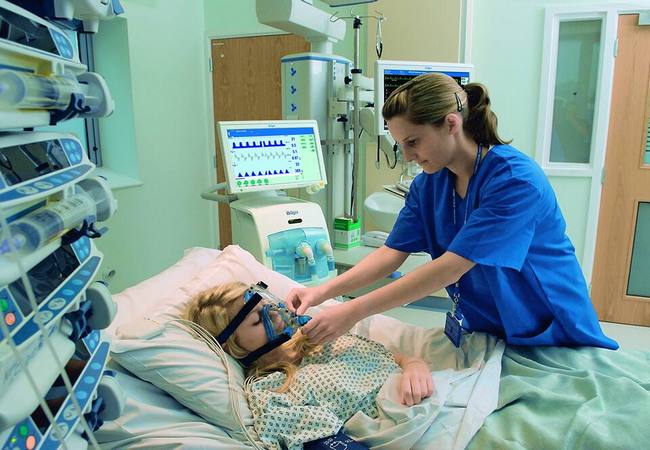Mechanical Ventilation or Ventilator Patient in ICU:
In medicine, mechanical ventilation is a method of artificial ventilation for the patient where mechanical means is used to assist or replace spontaneous breathing.

Nursing Care Plan for Mechanical Ventilator Patient in ICU:
Initial Settings of Ventilators in Admitted Patient in ICU:
Equipment:
- Manual resuscitator and appropriate size mask,
- Cardiopulmonary monitor,
- Pulse oximeter,
- Suction equipment,
- Intubation equipment,
- Stethoscope,
- Oxygen analyzer,
- Pressure monitor,
- Volume monitor,
- Timepiece,
- Device-specific humidification system,
- Device-specific patient interface and circuit including water trap system capable of closed, disposal of condensation (when necessary).
Procedure:
- Assure device readiness for use through evidence of calibration/performance verification.
- Assess appropriateness of physician’s orders and set ventilator parameters accordingly. Initial settings as well as changes to ventilator parameters must be accompanied by physician’s orders.
- Ensure proper device function with a test lung.
- Connect the patient to the device. Assess the patient for tolerance and the patient ventilator system for good coordination and proper function.
- Set all applicable alarms including alarms for thermal regulation of the humidification system.
- Perform a thorough assessment of the patient-ventilator system. Document ventilator data as well as cardiopulmonary data Perform repeat patient-ventilator checks as per policy.
- Monitor the patient continuously via cardiopulmonary monitor and pulse oximetry. Perform arterial pH and blood gas analysis and/or capnometry or transcutaneous monitoring as necessary and per physician order.
- Make recommendations for changes to the ventilator care plan as appropriate.
- Perform suctioning and other airway care interventions as clinically indicated to ensure optimal pulmonary management of the patient.
- Perform routine circuit and related equipment changes as per Section policy and whenever required to restore integrity of the circuit or when the circuit is visually soiled.
- Ensure that ventilator readiness data are filed according to section policy.
Post procedure:
- Refer to the operator’s manual and/or procedure for specific cleaning instructions.
- After appropriate disinfection and reassembly, perform a pre-use functional check according to Section policies.
Documentation:
1. A proper record of ventilator care should include documentation of at least the following every two hours:
- Ventilator settings comply with physician orders.
- The ventilator is functioning properly as evidenced by a check of measured volumes, rates, pressures, and Fi02.
- Alarms are appropriately set.
- Measured inspired gas temperature.
- Transcutaneous oxygen saturation (Sp02), carbon dioxide, or end-tidal carbon dioxide values (when available).
- The signature or initials of the person performing the patient-ventilator system check and the person’s credentials are documented at the time of the check.
2. A proper record of ventilator care should include documentation of the following, at least every twelve hours:
- Alarms are activated and respond appropriately.
- The patient’s artificial airway 1s secure and positioned as previously documented.
- A manual resuscitator and appropriate size mask are available at the bedside.
- Physician’s orders for ventilator parameters as written are up-to-date.
- Physical assessment results are documented.
3. A proper record of ventilator care should include documentation of the following as needed:
- Ventilator circuitry and/or manual resuscitation equipment is changed according to policy or as needed when visibly soiled or leaky.
- Changes to the ventilator parameters are documented at the time of change, and circled for easy identification.
- Airway care maneuvers (including suctioning) are documented when performed.

Maria Khatun Mona is a Founder and Editor of Nursing Exercise Blog. She is a Nursing and Midwifery Expert. Currently she is working as a “Senior Staff Nurse” at “Dinajpur Medical College Hospital”, Bangladesh. She has great passion in writing different articles on Nursing and Midwifery. Mail her at “maria.mona023@gmail.com”
